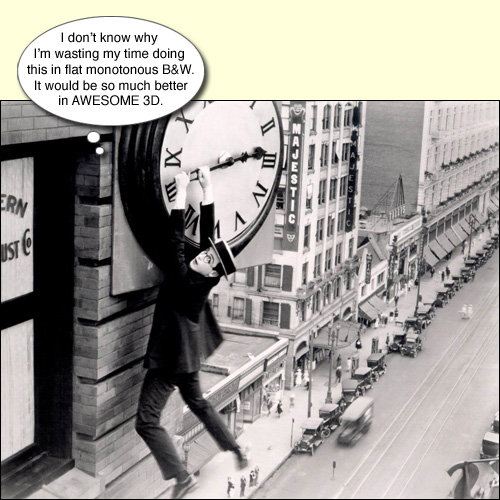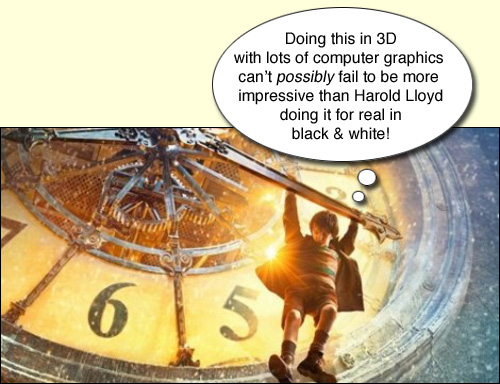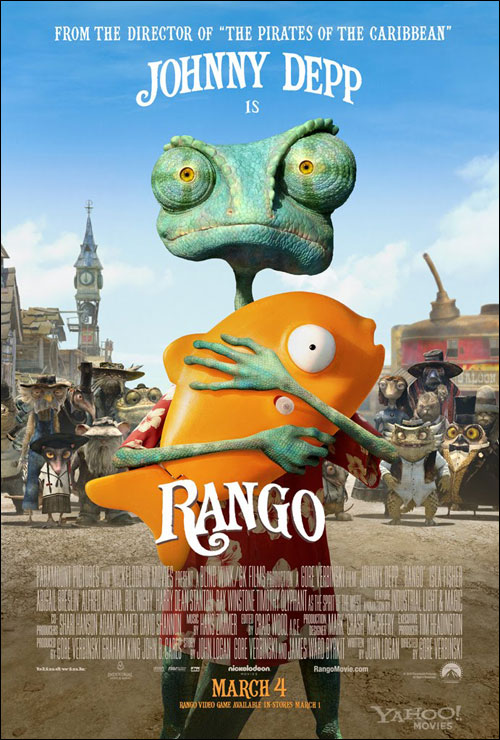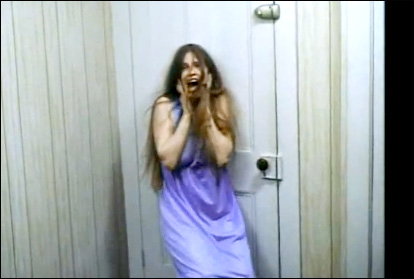Thu 2 Feb 2012
Hugo Potter
Posted by anaglyph under Movies
[4] Comments
(This is Part 2 of my review of Martin Scorsese’s Hugo You can read Part 1, which is mostly concerned with the film’s 3D, here.)
Clocks. Trains. Paris. Books. Magic. Méliès. Movies. Scorsese.
You could’ve pitched this movie to me in just those words and I’d’ve plonked my money down on the table. A tale about a kid who lives in the steampunk recesses of a Paris railway station and steals clockwork bits in order to repair a damaged automaton that can write? Count me in! A paean to the magic of cinema, the magic of magic, the power of imagination and the genius and vision of the eccentric and wonderful Georges Méliès? I am SO there. A story about fixing broken things and discovering their purpose which is really a metaphor for human loss? I love it!
So how did this film manage to piss me off quite so much?
Well, as I said in the last post, the 3D didn’t help matters any. And it wasn’t just the technical side of the 3D, nor the 3D filmic technique, which I think I’ve covered quite thoroughly. This film suffers from core conceptual problems that start with the pretentious use of the 3D and infect pretty much every aspect of the enterprise.
Just to set the scene (I’m sorry, there will be spoilers. If you haven’t seen the film, and you care, stop reading now):
Hugo Cabret (Asa Butterfield) is a young boy who, when we join the story, lives inside the less-travelled parts of the old Montparnasse station. In a flashback near the beginning of the film, his father (Jude Law) appears briefly to introduce Hugo (and us) to an intricate clockwork mannequin, who, he reveals, is an automaton that he has ‘rescued’ from the museum where he works. It is broken, but when Hugo asks ‘Can we fix it?’ his father says ‘Of course we can fix it!’ For Hugo and his dad (and Hugo’s uncle Claude, a sodden inebriate rendered in outstanding cliché by Ray Winstone) are clockmakers, and fixing things is their game.
Hugo’s father promptly vanishes from the story in a fire, his expositional purpose satisfied, and Hugo is marched off from his home to his new digs in the dark, steam-filled recesses of the train station where his Uncle Claude keeps the clocks running. Well, it’s better than being sent off to the orphanage, or so the film tells us. Unfortunately for Hugo, it turns out that rounding up orphans in the train station is the main preoccupation of the film’s antagonist (and comic relief), the Station Inspector (Sacha Baron Cohen). As the film gets into its stride, we gather that Hugo has been methodically stealing mechanical parts from an old man (Ben Kingsley) who sells toys from a stall on the station concourse. This, we eventually learn, is none other than the visionary filmmaker Georges Méliès, his life and career all but forgotten, eking out an existence barely ten paces off the frozen Paris streets. It turns out that the mysterious broken automaton (that Hugo is now attempting to repair on his own) is one of Méliès creations, and so the boy and the cinema magician are inexorably drawn together.
Even synopsizing it here for you makes it sound like a proposition that can hardly fail to be entertaining, and yet, for me, fail it did.
The ongoing friction between the Station Inspector and Hugo is sketched out in the film’s opening sequence, in which Hugo steals a croissant from a trolley (excuse me if I’ve got this wrong somewhat – as I mentioned last post, I was struggling to get my glasses clean and my eyes working through this early part of the film, so the details may be somewhat variant from what actually happened) and a frantic chase ensues. Or something. Anyway, there’s a very choppy action sequence in which we get our eyeballs pummelled and which involves slapstick funny walks from the the mobility-challenged Inspector. It is also the first of the movie’s clumsy cap-doffs to various other cinematic milestones, this one to the works of Jacques Tati. Soon afterward, Hugo meets the beret-bedecked Isabelle (Chloë Grace Moretz), who will eventually play, via the disclosure of a special heart-shaped key, an important part in the restoration of the mysterious automaton.
Isabelle, her eyes popping almost as much as the audience trying to grapple with the 3D, is desperate to have ‘an adventure’, and seems like she’s been snatched directly from the pages of The Famous Five.
Which brings me onto my first major gripe with the film – why does everyone speak plummy stilted Enid Blyton-style English in this movie? ‘Oh mother, please may I have buttered scones for tea – I’ll be jolly hungry if I have to go off to Pirate Island on an empty tummy!’ It’s set in France for Pete’s sake! Now, just because a film’s mise-en-scène is early 20th century Paris, I don’t expect an American studio to make it in the actual French language, but please, an effort, people? An accent? Anyone? I swear: we have a cavalcade of English actors in this film, from Richard Griffiths through Ben Kingsley and Jude Law to Christopher Lee, as well as the two marbles-in-the-mouth English kids, ((Well, OK, Chloë Moretz is American, but they slapped an English public school accent on her so thick that she’ll probably spend the rest of her career scrubbing it off.)) and there’s not an ‘Aw-haw-haw, ma leetle cornichon’ within coo-ee. It’s as if any accent that isn’t American is good enough for Americans to believe a story is set in ANY foreign country at all. I may be wrong, but my recollection is that the only person who attempted a French accent (and pulled off a decent one, at that) was Michael Stuhlbarg (playing René Tabard) and he’s one of the few frikkin’ Americans in the cast!
An American film with English people playing French people in a quintessentially French piece of history, with no sign of Frenchness except the set dressing (and some accordion on the soundtrack)? What the heck is going on here?
This blurring of Frenchness into Englishness seeps into everything. Isabelle loves to read, we discover, and frequents a bookshop presided over by the stern Monsieur Labisse (Christopher Lee). Who’s her favourite author? Dickens! What? Where are Victor Hugo and Gaston Leroux? Oh – who are they? Hugo has fond memories of his father reading to him as a child – Dumas’ ‘Three Musketeers’, right? Nope – it’s ‘Robin Hood’. This is not Paris, this is some kind of set-dressed Harry Potter version of Paris with croissants and berets and cafés but absolutely no hint of French artistic culture! And Georges Méliès played by Kingsley with an impeccable English demeanour? Huh? It crosses my mind that Marty Scorsese is afraid, maybe, that Americans might start to figure out that a country that doesn’t speak English was historically responsible for the invention of the magic of the cinema! ((Oh, I dunno. I’m just firing off shots in the dark. It just perplexes me that they couldn’t have at least given everyone a soft French accent. These people are actors. It’s not like they couldn’t do it.))
Because I was almost constantly aware of this affectation, ((Seriously – every time Isabelle says something like ‘It’s an adventure!’ I just wanted to smack her. It was like watching some terrible 1940s English kid’s movie.)) I couldn’t really tell whether the performances in Hugo were underwhelming, or whether I just thought they were, due to the persistant dissonance with the soul of the story.
The two kids in the main roles are perfectly OK, but they are certainly not deserving of the accolades I’ve seen in some reviews.
Hugo is played with jolting melodramatic pathos, and the genetic blessing of bottomless, pale blue eyes
… gushes Lisa Schwarzbaum from Entertainment Weekly, making ‘jolting melodramatic pathos’ sound like it’s a good thing. Isn’t he just channeling Mark Lester in Oliver? Could it possibly be that the critics have just been sucked in by a cute kid?
Butterfield and Moretz have a wonderful transparency
… says David Edelstein from NPR. Transparency? Huh? What the fuck does that even mean?
When we see a clip of Charlie Chaplin’s The Kid at one point in the film, I thought ‘Uh-oh. Best not linger on that too long Marty, or we might start to make comparisons…’ Anyway, whatever, like I said, the kids were fine, in a Five Go Mad in Dorset kinda way. As were all the adults: fine. There are no stellar performances in this film. Kingsley plods through as a grumpy Méliès, Jude Law reels out an acceptable ‘gee-whiz-golly-gosh’ dad, and Sacha Baron Cohen does the kind of usual schtick he does outside his own material. ((For me he mostly wasn’t funny. Another tip for Mr Scorsese: if you’re going to have a slapstick character in your movie, best not to refer to clips of the great physical comedians of the cinema, like Chaplin and Keaton and Lloyd, in the same film. It only serves as a reminder of how great they were and how much of a shadow a lesser performer can be.))
If something is more bothersome than the accents, it’s the non-sequiturs, oddities and contrivances of the lumbering plot. Why is Méliès so darn tetchy? When he burns Hugo’s father’s sketchbook partway through the film, and gives the charred remains back to Hugo, he just looks like an intractable and nasty old bastard. It’s a deed that is cruel and petty and I’m not sure what it was trying to tell us about his nature, unless it was that he is a mean-spirited character prone to vindictive acts. It serves no real plot point, since Hugo manages to repair the automaton without the book anyway. I understand why Méliès took the book, and I can even understand why he might have destroyed it, but not why the filmmakers felt compelled to have him give the burnt remnants back to the obviously distraught young boy. There is a sadistic quality in the whole idea that, in my opinion, is not motivated and never redeemed. It’s almost as if the sole reason the sequence exists in the film is to deliver a spectacular shot with some nice flakes of floating 3D ash. Surely not.
The principle motivation for Hugo wanting to restore the complicated clockwork automaton is that he seems convinced that, when it starts writing (the task for which it seems to have been created), it will deliver a message from his father. Why Hugo believes this is puzzling, because his father quite clearly tells him in the expositional flashback that he doesn’t know where the mannequin came from, who made it or what it will do when it is repaired and activated. The father is not in anyway implied to have been instrumental in its purpose. I guess we are supposed to chalk the boy’s odd conviction up to the confusion of his emotional young mind, but it seems to me to be something that really should have been ironed out in the writing.
Anyway, there are numerous discontinuities of this kind in the film, but I won’t belabour the point. The most egregious problem with Hugo is not in the details anyway, nor, really in the length of the film, which is the thing that has attracted most of the flak in negative reviews (a long film is not necessarily a bad film, although you do need to be on your game if you want your audience to stick with you for 2+ hours).
The worst thing for me about the movie was that it takes a bunch of fundamentally great ideas and trashes them. From the orphan-finds-his-true-place-through-adversity undertones of Oliver Twist, through slapstick cameo interludes that invoke the spirit of Jacques Tati, to the old-man-instills-love-of-cinema-magic-in-young-boy patina of Cinema Paradiso, Hugo cribs from the best, but manages to make all its borrowed ideas into lesser ones. For a film about magic, it felt to me leaden and dull. The few moments of true wonder – the mechanical man revealing his cryptic message; the emotional discovery by the children of Tabard’s Méliès museum; the recreation of Méliès’ film studio and sets – are crushed by mawkish melodrama and by the overbearing, heavy-handed contrivance of Scorsese’s desperation to make a statement with 3D. A film using a poorly-executed technical novelty about a genius of technical innovation? C’mon. Pretentious, much?
A modern audience can’t help but see Méliès’ footage as quaint and amusing, but we must remember that at the time, these were astonishing and innovative special photographic effects, and the fantastical creatures and landscapes of A Trip to the Moon were probably as impressive technically as we view the alien world of Pandora in Avatar today. In my view, Scorsese absolutely fails to get this idea across. Méliès was a complete master of special effects, having taught himself every aspect of the nascent film craft from the mechanics of the camera, through developing his own film, to designing the sets and the costumes (which, incidentally, were not realised in the bright colours that Scorsese shows us. Méliès discovered pretty quickly that colours behaved unpredictably when photographed in black & white, and so had all his sets and costumes manufactured in shades of grey). To even come within bowshot of using a special effect technique to illuminate this story, Scorsese would have had to have pulled something really special out of his hat, and I’m afraid that the best he could do was to produce a rubber chicken. ((I do wonder whether, for many people who liked this film, the real reason is that they simply had never heard of Méliès before, and the revelation of his great cinema genius is like a magic trick in itself. I remember discovering him several decades ago and almost jumping for joy that such an inspired filmic lunatic had existed there, right at the Dawn of Cinema. I felt he was so much like myself at the time: he was bored in school as a kid, was constantly tinkering with gadgets, was fascinated by science fiction and fantasy (and real science too), loved photography and stage magic and had an unquenchable desire to illuminate the minds of audiences with bizarre and fantastical tales. He stands as one of the great visionaries of the cinema and is rightly deserving of wide recognition.))
At the end of the movie when we see documentary footage from World War 1 rendered into 3D, I was ready to throw stuff at the screen. When Scorsese had the temerity to do the same thing to the original Méliès footage in the following sequence I knew he’d lost all respect for the great man, for cinema and for his audience. Making an ‘improvement’ over the the films of George Méliès by making them 3D is a cheap concession to special effects. It’s a childish ‘We’re SO clever – just look at what we can do now!’ that adds exactly nothing to the idea except the sheen of Hollywood condescension.
Setting the Méliès story inside another more emotionally simplistic story felt to me intrinsically flawed, too. It might have worked, I suppose, but the young Hugo’s melodramatic tale, laced with workhouse pathos as it is, somehow points up the wrong things about Méliès work, reinforcing a modern perception of his filmic exploits as hammy and staged. The same problem is evident in Merhige’s 2000 Shadow of the Vampire. The makers of that film likewise interpret proto-cinema (in their case, Murnau’s astonishing Nosferatu) through modern sensibilities and attempt to couch the whole affair in a kind of pantomime. To do such a thing is to profoundly misunderstand the genius of these early moving pictures.
For me, the greatest disappointments in cinema often follow this model; the promise of something great is dashed by the filmmakers losing track of the purity and integrity of the original idea. I am left wondering if John Logan’s script could have worked in someone else’s hands; if, had 3D not been an issue, it could have been executed differently and survived its other flaws; if, indeed, that any director could convey the visions of Georges Méliès to a modern audience in a way that was true to his real brilliance? Possibly not. But one thing is for sure: for me, at least, Martin Scorses’s Hugo doesn’t even come close.
And that is a great pity.








